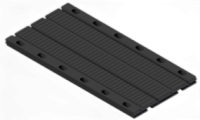Expansion joints
Expansion joints ensure a continuous surface for traffic on structures regardless of the deformations induced by temperature conditions, wind, traffic, or any other effect while maintaining the water tightness of the rest of concrete or steel deck.Expansion joints provide a continuous road surface to all users of a road or railway while at the same time ensuring water tightness as well as allowing every displacement or rotation expected at the structure.
A wide array of types and models ensures that every structural work situation anywhere in the World can find a suitable solution within MK4 catalogue.
Design & Manufacturing
Our structural joints can be designed and manufactured for any load and displacement required by international standards like ETAG or AASHTO LRFD and have been approved by road authorities all over the World


MK4 joints are widely used in structural, marine and civil engineering applications, mainly in bridges. Joints are available in rubber and carbon steel as standard, and can have components made in aluminum or stainless steel for applications where corrosion is a potential problem. Each particular project has specific needs that require a tailored joint for maximum efficiency at minimum maintenance.
MK4 joints are widely used in structural, marine and civil engineering applications, mainly in bridges. Joints are available in rubber and carbon steel as standard, and can have components made in aluminum or stainless steel for applications where corrosion is a potential problem. Each particular project has specific needs that require a tailored joint for maximum efficiency at minimum maintenance.
Modular Expansion Joint
High performance steel bridge joint where total movement gap is divided into individual gaps, where expansion/contraction is ensured by a rubber V-shape profile linking two steel center beams. Center beams ensure bearing capacity towards traffic loads, rubber profiles ensure water tightness and movement capacity.



Rubber Expansion Joint
High performance lastomeric expansion joint allowing absorption of deck movements and water evacuation, bearing the traffic loads and avoiding the traffic disturbances. The continuous rubber surface (with or without metal plates) ensures water tightness at the joint level, without any need for additional water removal devices before surface level. Thus, rubber expansion joints can be installed on the thinnest structural slabs and bridge decks

Finger Expansion Joint
High performance steel expansion joint allowing absorption of deck movements whilst bearing the traffic loads and avoiding traffic disturbances. The steel fingers provide a robust surface for traffic with low noise, and can be tailored to allow a great variety of movements.



Pedestrian Expansion Joint
Steel plate expansion joint, is a mechanically sealed joint designed for pedestrian traffic on bridge kerbs, as well as pedestrian bridges. It consist on a steel plate providing a continuous surface for the users which slides over another steel plate inserted on the kerb surface. An elastomeric seal is mechanically locked into the cavity of steel extrusions to prevent the ingress of water or debris. Below the steel plates, anchorage is affixed to be attached to the structure elements by a typical method of pouring high-strength concrete mortar, or other elastomeric mortar.This armored joint system is designed to cater for movement matching those of the main expansion joints, with an exterior surface conveniently treated to prevent trips and slips by the users.

Simple Expansion Joint
Simple Expansion Joint, is a mechanically sealed joint with an extruded elastomeric seal retained by various options of profiled steel extrusions, often referred to as edge beams or steel rails. The elastomeric seal, usually named strip seal, is mechanically locked into the cavity of steel extrusions to prevent the ingress of water or debris. At the side of steel extrusions, anchorage is affixed to be attached to the structure elements by a typical method of pouring high-strength concrete mortar, or other elastomeric mortar.This armored joint system is designed to cater for movement ranging from 0mm to 100mm, while movements and rotations in all three axes are possible without any restraints.


Other Products
Get in Touch
Get in touch today and explore project options







